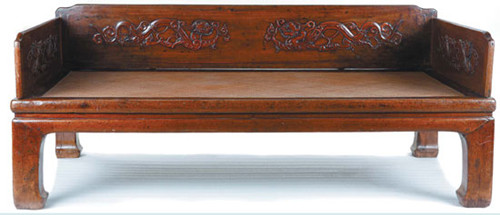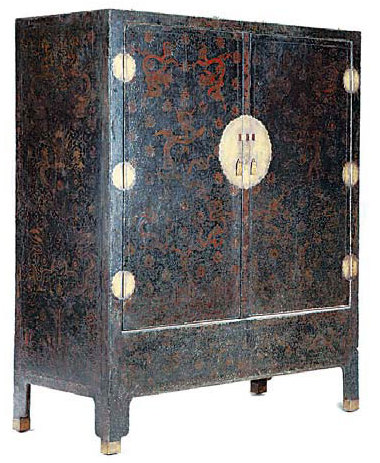
A luohan bed sculpted with dragon patterns from the early Qing Dynasty (1644-1911).

A cabinet with black lacquer and golden lotus flower patterns.
The National Museum of China presents furniture made from precious jinsi nanmu, or 'golden thread wood'. Lin Qi discovers this alchemic timber's magic.
A massive swath of trees in Sichuan province's remote mountains was logged about six centuries ago.
But these weren't just any trees that were felled and shipped along the Yangtze River and Beijing-Hangzhou Grand Canal before arriving at the Forbidden City's construction site.
These trees were of the jinsi (golden thread) variety of nanmu - a highly valued type of large, slow-growing evergreen.
They became the Fengtian Palace's pillars. The palace later burned to ashes.
But the inclusion of jinsi nanmu in construction became an imperial custom in the Ming (1368-1644) and Qing (1644-1911) dynasties.
It was also used to make luxury furniture both inside and outside the palace.
An ongoing exhibition at the National Museum of China displays the beauty of jinsi nanmu furniture. It includes nine exquisite antiques from the Ming and Qing periods that are available for public viewing for the first time.
"When ancient carpenters split nanmu, they found the sap inside crystallized and glittered like golden threads in the sun," antique furniture expert Zhang Dexiang says. "That's how it came to be called jinsi."
Jinsi is considered the best nanmu variety.
Its resistance to decay made it a favorite of royal families and dignitaries. It's also easy to carve but doesn't warp easily.
"The wood has a fine, smooth texture," Zhang says.
"It also emits a faint fragrance. The color is pleasant but not very eye-catching. It has all the qualities ancient literati asked for - resilience, freshness and elegance."
A highlight of the exhibition is a large qiaotou'an table with two recessed trestle legs and upturned ends. The large piece - created sometime in the period spanning the late Ming or early Qing dynasties - is 4.34 meters long and 1.01 meters high.
But despite its dimensions, the table's appearance is anything but awkward because of its simple angles.
The shelf's mushroom and cloud patterns embellish the otherwise simple structure with ornate flair.
Jinsi nanmu logging was the exclusive privilege of imperial families before Qing Emperor Daoguang (1821-50). In the Ming and Qing dynasties, use of the wood in constructing buildings required court approval. But ordinary families fashioned furniture from it during this period.
Visitors to the exhibition can also learn about and appreciate the sophisticated techniques used to make furniture in times of yore. Carpenters passed down these tricks of the trade for generations.
One exhibit, for instance, displays an antique bed that's disassembled to clearly show its mortise and tenon structure.
A special section presents furniture sets designed by contemporary connoisseurs.
"Nanmu furniture was not so popular among collectors, but now, there is a new trend," says Curtis Evarts, an American connoisseur of classical Chinese furniture in Shanghai.
"Besides appraising the material itself, I hope people can pay equal attention to the design."
He designed several pieces of furniture at the exhibition, including a four-legged silver ingot incense stand.
"The difficulty in designing this stand is that it has no straight line," he says.
"I have to take care of every curve and circular measure. Even a simple-looking piece deserves careful consideration of a lot of details.
"You don't have to do much sculpting on furniture made of jinsi nanmu, as the natural grain is refined enough. People only need to appreciate the expressiveness of the design and the philosophy of ancient literati."

Copyright ©1999-2011 Chinanews.com. All rights reserved.
Reproduction in whole or in part without permission is prohibited.